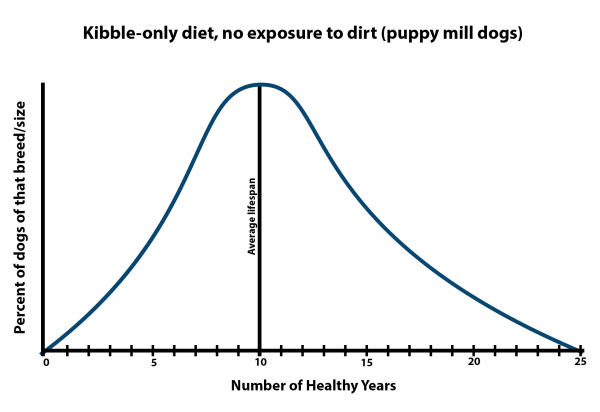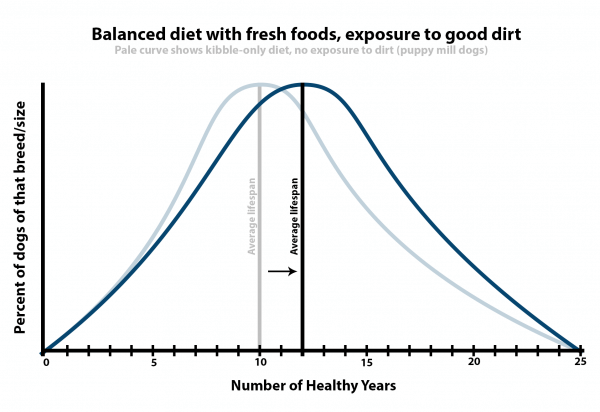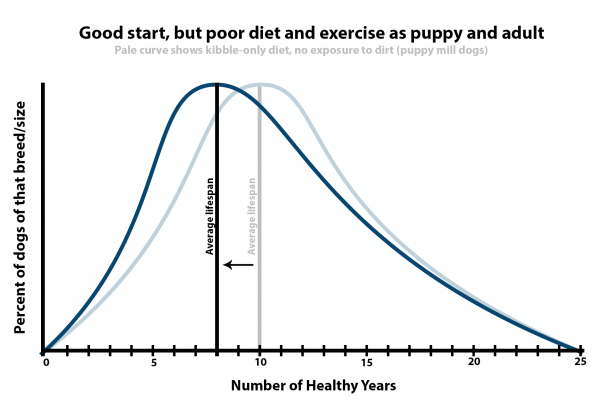Fresh Food and Good Dirt During Early Growth
12/6/17

Last Updated on
by Steve Brown
The Importance of Fresh Food and Good Dirt from Preconception Through Early Growth
So You’re Raising a Young Puppy …
When your new pup is still in the womb to when she is still just a few months old, fresh food and good dirt are absolutely crucial. I’ll explain what I mean.
Well-made raw meat-based diets “help bring out the full health potential of most dogs and cats.” In an earlier blog I wrote that the full health potential of your dog or cat is based upon your dog’s genetic inheritance; her epigenetic inheritance, including what her mom and dad ate before conception; her diet and exposure to microbes as a fetus and early growth; and what you do when you get your puppy. Here is some more information for families inviting a young puppy home:
Move the Curve to the Right
In other words, good foods and healthy environments increase the probability that your dog will live a long, healthy life with minimum veterinary bills. They don’t guarantee a long life or no vet bills: even the best-fed and best-bred puppy can have health problems. But every step you take increases the probability that your dog will thrive—or, as I like to say, every step you take “moves the curve to the right”.
If you’re getting a puppy, work with the breeder to ensure that, starting a month or so before conception, the mom and dad eat balanced diets with at least some fresh foods. In addition, once the puppies are two weeks old or so, ensure they get to eat and play in good dirt. (Our full advice is below.)
Each of these steps moves the probability curve to the right.


Every step the breeder takes to improve the diet and environment of the mom and pop before conception through the time you get your puppy moves the curve to the right.
Note that some puppies will live a very long time, and some won’t live as long as we’d like. By moving the curve to the right, fewer will die at young ages, and more may become longevity superstars.
With a good breeder, your puppy is off to an excellent start. The rest is up to you. If you feed poorly, don’t exercise your dog, and allow her to get fat, you’ll move the curve to the left.

Probably the most important time for great nutrition is a few months before conception for both the mom and the dad through weaning. (The nutritional status of the dad is passed on through his sperm.) From a canine life stage point-of-view, we call these preconceptions, gestation, lactation, and early growth (less than 14 weeks old).
For example, recent research shows that a human’s and a mouse’s father’s folate levels at the time of conception may be just as important to the development and health of their offspring as are those of the mother. Indeed, the study suggests that fathers should pay as much attention to their lifestyle and diet before they set out to conceive a child as mothers do.[i] But too much folic acid/folate supplementation can be just as detrimental as not enough folate[ii].
Visit the Breeder
I want to share some no- and low-cost ways for you to work with the breeder to provide your puppy an excellent health foundation upon which you can continue to build. In this blog, we assume that the breeder is feeding an inexpensive and “complete and balanced” dry dog food. Many breeders feed inexpensive dry foods because, with a lot of dogs to feed, fresh meat-based diets can become very expensive. Here’s what to do when you visit your pup’s breeder:
-
Examine the Food
First and foremost, make sure the dry food is recently produced, handled properly, and used quickly. If you visit the breeder and see a large bag of dry food left open in a humid room or hot room (think a garage in the summer), I suggest going to another breeder or getting a rescue dog. Prevent rancid fats! Rancid fats move the curve to the left, reducing the expected health span of your puppy.
I recommend feeding dry foods without fish oils, with the fish oils (or fish) added at the time of serving. Fish oils are stable in the package until it is opened. Once the bag is opened, the fragile fats in fish oils, especially EPA and DHA, can turn rancid quickly.
-
See Where the Puppies Play
After you look at the food, check out the places where the puppies will play. If they are always inside, playing on typical slippery surface flooring, talk to the breeder. If they never have a chance to eat fresh, clean dirt, question how you’ll be able to build a healthy gut microbe population.
Good dirt is natural, meaning no pesticides or lawn chemicals, as well as no exposure to dogs with parvo and other diseases.
This is a crucial time for the pups to go outside and eat dirt and other microbe-rich foods to develop healthy gut microbiomes. The natural diet of puppies included lots of microbe-rich foods. Developing a healthy gut microbiome as a puppy is essential in order to bring out the full health potential of the dog.
Also, I think it’s important for the pups to play in the dirt rather than on slippery floors. The epidemic of ACL tears may be partially due to puppies playing on slippery surfaces rather than playing in the dirt.
But many breeders are more afraid of diseases such as parvo than they are concerned with gut digestive systems of the offspring as adults—and understandably so. So they clean with bleach (a big NO for the health of the puppies when they are adults) and prevent the pups from being exposed to healthy microbes. If we can make puppy buyers understand this, it’s the end of puppy mills. It’s more than food, puppy mill people!
Early and frequent exposure to clean dirt for eating and playing moves the probability curve to the right, extending the probable lifespan of the puppy.
Boost Your Puppy’s Diet Before You Get Them
There are a number of ways to boost your dog’s diet, but you need to tread carefully. Do not add vitamins and minerals supplements to complete and balanced dog foods, especially from preconception through weaning. Too much of a nutrient, especially iodine and folic acid, is just as bad as (or even worse than) not enough. Instead, you should add whole foods.
Add limited amounts of select whole foods, and keep the diet balanced. Some dry foods contain just the recommended minimum amounts of many nutrients (not optimum amounts); therefore, adding any foods without specific nutrients may cause deficiencies.
For example, I’ve seen some popular puppy foods that contain the absolute minimum amounts of calcium, and adding any foods except small amounts of leftover vegetables would reduce the overall diet content of calcium below a minimum.
One of the most remarkable studies I’ve seen came from Sweden. The study concluded that feeding any homemade or non-commercial foods to a pregnant dog during lactation protected her offspring from subsequently developing skin allergies as compared with feeding just commercial foods.[iii]
No-Cost Diet Additions
- Leftover vegetables
Low-Cost Diet Additions
- Fish oils from fresh source
- Egg Yolk: If the only source of choline in the dry food fed is choline chloride; the food does not contain egg yolk and is not a high meat and organ content food, add one egg yolk per week. I think it’s important that the pregnant mom has natural sources of choline.
Moderate-Cost Diet Additions
One of my goals with the moderate cost approach is to ensure the moth and the puppies consume some natural, whole food sources of all AAFCO and FEDIAF recommended nutrients. When feeding many dry foods, almost all the sources are supplements. Some of the better dry foods have natural sources as well, but they are processed at high temperatures and pressure, and changes may occur.
This moderate-cost approach meets AAFCO and FEDIAF minimum recommendations for all essential nutrients: fatty acids, minerals, vitamins, and amino acids. But this diet is not for daily feeding—it’s for providing fresh whole foods on a daily basis to the gestating female and the puppies.
This is a 315 kcal weekly plan. For a typical 40-pound dog, add something every day. If you have a 100-pound dog, double this. If you have a 15-pound dog, reduce by 50 percent. Decrease the amount of kibble by about 1 cup per week for this plan. If you feed a raw diet that is complete and balanced for growth stages, such as Darwin’s meals, cut out one day per week.
Remember, do it right according to this plan, or just stick to the low-cost/no-cost plans (for instance, by adding small amounts of leftover vegetables).
- 1 oz. beef liver, weighed raw, served raw or cooked (added protein, minerals, vitamin B12; no more, otherwise too much copper). Estimated cost $0.45
- 5 to 2 grams of calcium carbonate or dried egg-shell powder, 1.5 for large and giant breed puppies; or 4 grams calcium citrate. We want 0.5 grams of calcium. $0.25
- 1 whole egg, raw or cooked (choline) $0.50
- 1 can or 3.5 ounces of pink wild salmon, with bones (fatty acids, vitamin D, and much more). $4.99
- 1 can or 3.5 ounces of oysters (best source of zinc, mineral rich, and fatty acids) $4.99
- 5 ounces of leftover green vegetables such as broccoli or spinach $0.00
Tallied up, the weekly cost is $11.50. Over the course of a litter, the additional cost of this approach is less than $300, or, for a typical 7-puppy litter, less than $50 per puppy.
OR:
1 day/week of complete and balanced for growth stages raw diet, such as Darwin’s.
When you get a new puppy, not all factors are within your control. However, by working with your pup’s breeder and providing the best food you possibly can, you’re taking important steps you to move the curve to the right. And that’s the best way to increase your odds of enjoying many happy years with your new pet.
[i] R. Lambrot, C. Xu, S. Saint-Phar, G. Chountalos, T. Cohen, M. Paquet, M. Suderman, M. Hallett, S. Kimmins. Low paternal dietary folate alters the mouse sperm epigenome and is associated with negative pregnancy outcomes. Nature Communications, 2013; 4 DOI: 10.1038/ncomms3889 McGill University (2013, December 10). You are what your father eats: Father’s diet before conception plays crucial role in offspring’s health, study suggests. ScienceDaily. Retrieved December 11, 2013
[ii] Johns Hopkins University Bloomberg School of Public Health. “Too much folate in pregnant women increases risk for autism, study suggests: Researchers say that while folate deficiency is bad for developing fetus, excessive amounts could also be harmful.” ScienceDaily. ScienceDaily, 11 May 2016.
[iii] Nodtvedt A et al. “A case-control study of risk factors for canine atopic dermatitis among boxer, bull terrier and West Highland white terrier dogs in Sweden.” Veterinary Dermatology. 2007 Oct;18(5) 309-315. The study data showed that the odds of the puppies developing skin allergies were twice as high among the offspring from mothers that ate only commercial foods.

Steve Brown is a dog food formulator, researcher, and author on canine nutrition. Developer of the first AAFCO-compliant raw dog food, and one of the leading low-calorie training treats, Charlee Bear® Dog Treats. He is also the author of two books on canine nutrition (See Spot Live Longer, and Unlocking the Canine Ancestral Diet (Dogwise Publishing, 2010); and a 40-page booklet, See Spot Live Longer the ABC Way.



